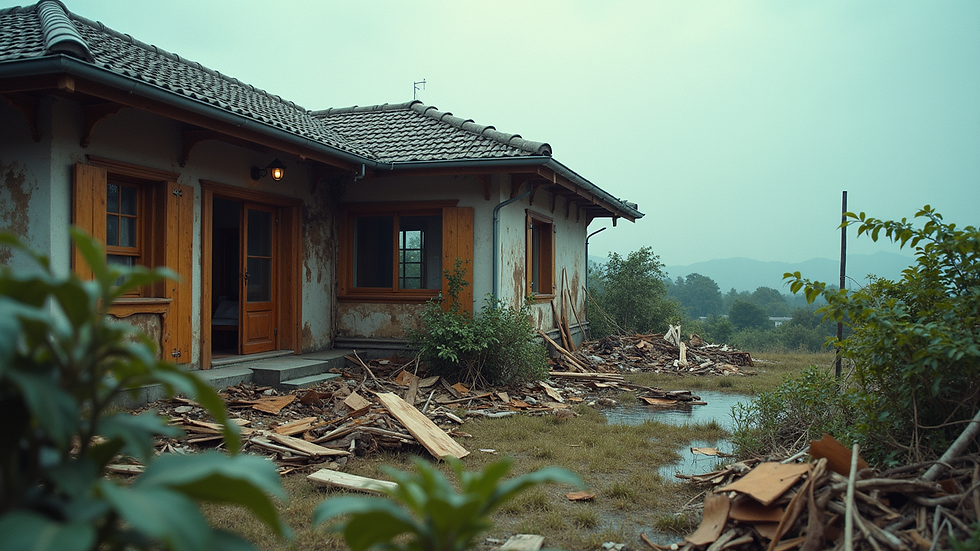Surviving the Storm: Key Lessons from Recent Typhoons in the Philippines and Must-Have Insurance Tips
- SJ&P | Wealth Advisory

- Jul 23
- 4 min read
By: King San Josè- Santos,RFP, CFC,CTA, FIFC
Chief Financial Planner | SJ&P Wealth Advisory
The Philippines faces a tough reality each year with numerous typhoons crashing through its islands. These storms can cause significant destruction, affecting lives and communities. Recently, we've seen the impact of powerful typhoons, illuminating the importance of preparation, resilience, and having the right insurance. Whether you've lived here for years or are just starting your journey, understanding how to handle the aftermath of these storms is crucial. In this blog post, we'll share essential lessons from recent typhoons and outline the types of insurance you should consider to safeguard your home and family.
Understanding the Impact of Typhoons in Philippines
Typhoons in the Philippines are more than just bad weather; they can drastically alter lives. With wind speeds soaring up to 200 kilometers per hour, homes can be obliterated, families can be torn apart, and entire neighborhoods can be displaced.
For instance, Typhoon Haiyan in 2013 displaced over 4 million people and caused damages exceeding $14 billion. These statistics underline a harsh truth: each storm doesn’t just leave physical destruction but deep emotional wounds in the community.
Lessons Learned from Recent Typhoons
1. Preparedness is Key
One of the most important lessons is that preparation truly matters.
It's about creating a detailed emergency plan, which should include:
Defined meeting spots for family members
Emergency contacts
A checklist of essential items to grab during an evacuation
Communities that form action groups recover faster. A neighborhood in Tacloban, for example, organized training and evacuation drills, allowing them to respond effectively when Typhoon Agaton struck in 2022.
2. Stay Informed
Having real-time information during a typhoon can be critical.
Utilize mobile alerts, radio updates, and social media for critical news about the storm’s path and intensity.
During Typhoon Odette, many people turned to local news sources for updates, which highlighted the importance of following trusted channels for timely information.
3. Reinforce Your Home
Home construction matters more than many realize.
Investing in stronger roofing materials, reinforcing walls, and elevating homes in flood-prone areas can significantly minimize damage.
For example, homes built to withstand strong winds saw a 40% reduction in repair costs post-typhoon. Consulting with experts on disaster-resilient homes can save you money in the long run.
4. Community Support is Essential
The power of community cannot be underestimated.
After a typhoon, neighbors often assist each other with rebuilding efforts. For example, in Bohol after Typhoon Agaton, local groups banded together to provide shelter, food, and rebuilding resources to the most affected.
Local organizations mobilize quickly to offer much-needed support. Knowing how to access this assistance can lighten the load during recovery.
5. Mental Health Matters
The emotional toll of a typhoon can be significant.
Survivors often face stress, anxiety, and depression long after the storm passes.
Communities that actively offer mental health resources tend to experience smoother recovery processes. For example, programs in Cebu launched post-typhoon counseling services that reported a 60% increase in community members seeking help.
Essential Insurance Types to Consider
While being prepared is crucial, having the right insurance can also provide peace of mind when disaster strikes.
Consider reviewing or acquiring these insurance types:
1. Homeowners Insurance
Homeowners insurance covers damage to your home and belongings caused by natural disasters, including typhoons.
Ensure your policy includes flood coverage, as standard policies often exclude it. Regularly review your policy to confirm you have adequate coverage.
2. Flood Insurance
For those in flood-prone areas, flood insurance is non-negotiable.
Even if your homeowners insurance partially covers water damage, a separate flood policy can provide enhanced protection. Consult your insurance provider to explore options.
Click here to reach out to us if you require flood insurance >
3. Vehicle Insurance
For residents in typhoon-prone regions, comprehensive vehicle insurance is a wise choice.
This coverage helps pay for damages to your car caused by natural disasters such as floods or debris from storms. Make sure to clarify what your auto policy covers regarding such damages.
4. Business Insurance
Business owners should prioritize robust insurance to cover potential losses.
Business insurance protects against inventory loss, property damage, and operational interruptions due to typhoons. It's vital to discuss specialized policies that fit your business needs with an insurance agent.
Tips for Choosing Insurance
As you look into different types of insurance, keep these tips in mind:
Assess Your Risks: Understand the risks of your area. If you live in a high-risk flood zone, ensure you prioritize flood insurance.
Shop Around: Don't accept the first policy you find. Get quotes from multiple insurers and compare their coverage.
Understand the Fine Print: Read your policy details carefully. Know what's covered and what isn’t, including deductibles.
Update Regularly: Life changes—be it renovations or financial shifts—should prompt a review of your coverage to ensure it aligns with your current needs.
Summary of Key Takeaways
Surviving a typhoon isn’t just about physical readiness; it involves being informed, supported, and financially secure.
Lessons from recent typhoons in the Philippines highlight the significance of community preparedness, mental health support, and having proper insurance.
By embracing these lessons, you can foster a stronger foundation to weather the storms that nature brings.
Moving Forward with Confidence
Living in a typhoon-prone region can feel overwhelming, but remembering these lessons can help ease those fears.
Preparation, community involvement, and securing adequate insurance are effective strategies for navigating the challenges of typhoons. Use these insights to empower yourself and secure what matters most: your home, loved ones, and peace of mind.

Need to protect your assets now? Contact us today. Receive quick quotes, complete your application, and enjoy comprehensive premium service.





Comments